The Search for the Portrait that Belonged to Kittel Pages at The Face Of Bach
The Queens College Lecture of March 21, 2001 - Page 13 - Why the Weydenhammer Portrait Fragment is what remains of the Portrait of Bach that
Belonged to Kittel
The Face Of Bach
This remarkable photograph is not a computer generated composite; the original of the Weydenhammer Portrait Fragment, all that
remains of the portrait of Johann Sebastian Bach that belonged to his pupil Johann Christian Kittel, is resting gently on the surface
of the original of the 1748 Elias Gottlob Haussmann Portrait of Johann Sebastian Bach.
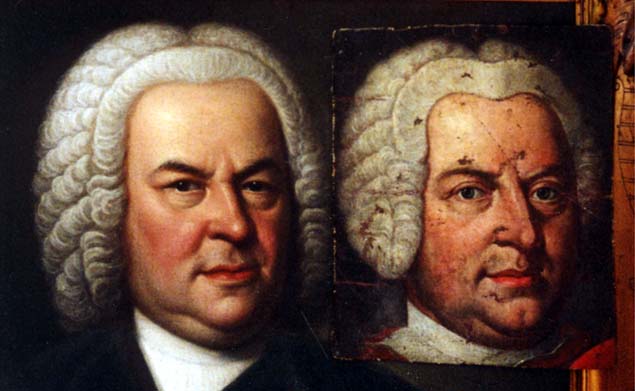
1748 Elias Gottlob Haussmann Portrait, Courtesy of William H. Scheide, Princeton, New Jersey
Weydenhammer Portrait Fragment, ca. 1733, Artist Unknown, Courtesy of the Weydenhammer Descendants
Photograph by Teri Noel Towe
©Teri Noel Towe, 2001, All Rights Reserved
The Search for the Portrait that Belonged to Kittel
The Queens College Lecture of March 21, 2001
Page 13
Why the Weydenhammer Portrait Fragment
is what remains of
the Portrait of Bach that Belonged to Kittel
Now that I have proven by a preponderance of the evidence, if not beyond a reasonable doubt, that the early 18th century
application of oil paint to the properly prepared, contemporaneous, early 18th century bolus on the scrap of canvass of the correct
date that I call the Weydenhammer Portrait Fragment is an accurate depiction of the facial features of a Johann Sebastian Bach who
was 25 to 30 pounds lighter and ten to 19 years younger than the Johann Sebastian Bach of the Haussmann Portraits, I shall now
prove by a preponderance of the evidence, if not beyond a reasonable doubt, that the Weydenhammer Portrait Fragment is what
remains of the portrait of Bach that belonged to his pupil Johann Christian Kittel.
Before I begin this aspect of my presentation, please forgive my being even more redundant than usual, but I shall feel more
comfortable if I remind you of three of the assumptions that underlie this attempt to provide a proof for the Fermat's Last Theorem
of Bach Iconography.
Those assumptions, those postulates, if you will, are:
1. Hilgenfeldt's description of the painting is accurate: "...ein Brustbild, Bach im Staatskleide darstellend" (A bust portrait, Bach
presented in official regalia);
2. The painting was painted for Christian, Duke of Sachsen-Querfurt und Weissenfels during Bach's tenure as his Capellmeister
von Haus aus, between 1729 and 1736; and
3. According to the auction catalogue for the sale of Kittel's library and musicalia, the painting measured two Prussian feet by two
Prussian feet, four inches, or, approximately the same size as the two Haussmann portraits.
First, the Weydenhammer Portrait Fragment is the correct size to be the head of a bust portrait the size of the Haussmann Portraits.
Thanks once more to the kindness and generosity of Bill Scheide, I can demonstrate this fact in the most powerful way possible.
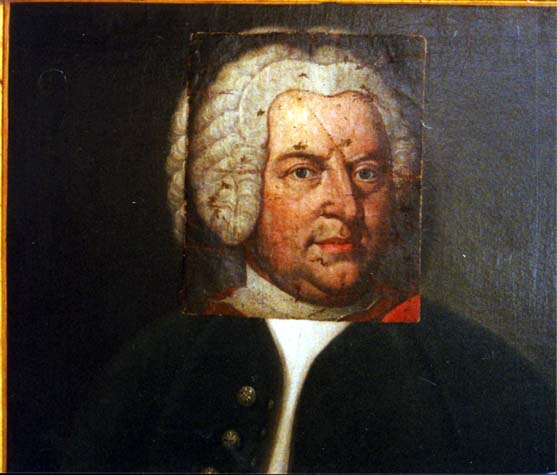
This remarkable image is a reality, thanks to Bill's having allowed me to place the original of the 1748 Haussmann flat on the floor of
the living room in Library Place, gently place the original of the Weydenhammer Portrait Fragment over the face, and then
photograph the "montage" with a camera mounted on a tripod. This comparison is not computer generated. And, let me add that, in
looking at this photograph for the first time, I realized that is serves a double probative purpose. Not only does it show that Bach's
head is the correct size for a bust portrait of the dimensions of the painting that was sold at the auction of Kittel's estate, but also it
shows, to my astonishment and delight, that the shoulders of the Weydenhammer Portrait Fragment, right and left, match the
shoulders of the 1748 Haussmann perfectly. This match also reinforces the difference in weight, by the way. That Bach's head is
slightly larger in the 1748 Haussmann portrait is directly attributable to his added weight, as you can see from this image [the same
one that is to be seen at the head of each page at The Face of Bach], which I took a few moments before I made the montage
image.

All right, I have demonstrated that the head of Bach that is the Weydenhammer Portrait Fragment is the correct size to have been
the head of the bust portrait that Hilgenfeldt describes, but that head could have been practically anywhere in a much larger, or for
that matter, a much smaller canvass. Please now look once more at the back of the Weydenhammer Portrait Fragment.

As you may recall, one of the first observations that Alain Goldrach made about the Weydenhammer Portrait Fragment was that it
had been cut out of the top portion of a significantly larger canvass. In telling me so, he had, unwittingly, anticipated one of my
questions, namely, was there any way to tell from what approximate portion of a larger canvass the Weydenhammer Portrait
Fragment had come. It is not the easiest thing to see in the photograph, but the warp and woof, the weave of the canvass, is
scalloped at the top. You can just make out the undulating pattern at the very top. Here is a detail that I hope will make it a little bit
easier to see.

This scalloping, this undulation, is the result of the pulling of the canvass as it is stretched tightly over the stretcher, The scalloping
occurs only near the edges, and, since there is no scalloping along either the side or the bottom edges of the Weydenhammer
Portrait Fragment, the logical inference is that it comes from the top portion of the original painting.
Hilgenfeldt writes: "...Brustbild, Bach im Staatskleide darstellend".
If the painting was commissioned by Christian, Duke of Sachsen-Querfurt und Weissenfels, as it is believed to have been, can the
tiny bits of raiment that are visible in the Weydenhammer Portrait Fragment be linked in any way to the official regalia, uniforms, or
livery that were worn by the officials and the employees of the ducal court?
I had made little progress in this area of my researches until Thursday afternoon of last week [March 15, 2001], and the
breakthrough was made in this very building [the Aaron Copland School of Music]. I came out to meet with the fabulous folks who
made this presentation a practical reality, and, afterwards, I was working with Raymond Erickson, in his office. At one point, while
he was on the telephone, my eyes wandered to the books on his shelves. I spotted the illustrated catalogue for an exhibition that
was mounted in Weissenfels several years ago, on the occasion of the 300th anniversary of the completion of the ducal castle, the
Augustusburg.
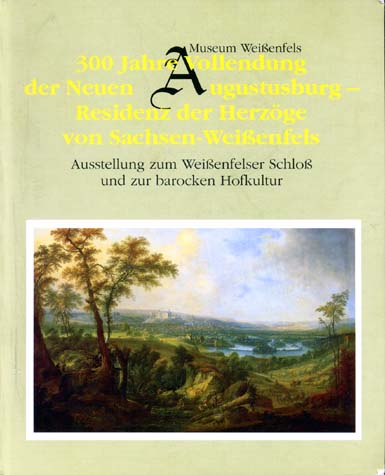
In it, to my delight, I found what I had hoped eventually to find, and it proved to be what was needed. The iconographic evidence
of which I found reproductions in this catalogue, which Ray very kindly let me borrow, not only confirms my initial information
that, at least on some occcasions, the official colors of the dukes were red and white, but also made it possible for me to determine
precisely the nature of the garment that Bach is wearing over his formal shirt in the Weydenhammer Portrait Fragment.
Please look first at this pair of hand-tinted prints from a portfolio that was compiled especially for Christian's older brother and
immediate predecessor, Duke Johann Georg:
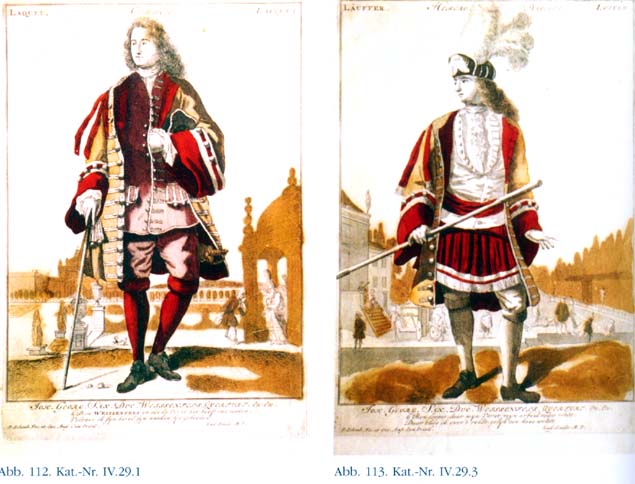
Livery at the Court in Weissenfels was red and white, and Bach is wearing red and white in the Weydenhammer Portrait Fragment.
As you can see from this detail of the lefthand image, the garments were often red, trimmed with white.
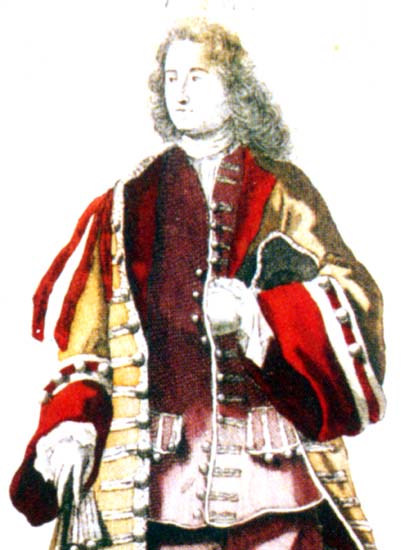
So, in the Weydenhammer Portrait Fragment, Bach is dressed in the correct colors for Weissenfels Staatskleide. Now, what on
earth could that bizarre bit of scalloped edged material over his shirt be? I got my first hint from a portrait of Christian's father,
Duke Johann Adolf I, the Duke who, according to the anecdote that John Mainwaring got from Handel, forced Handel's
barber-surgeon father to arrange for his son to take proper music lessons from Zachow:
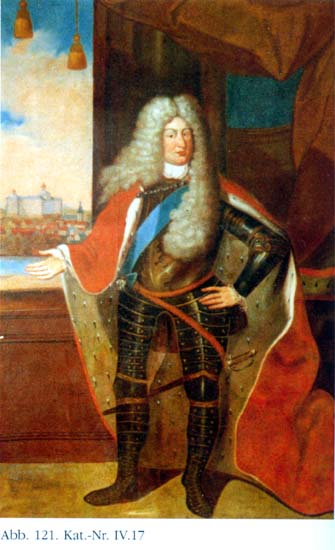
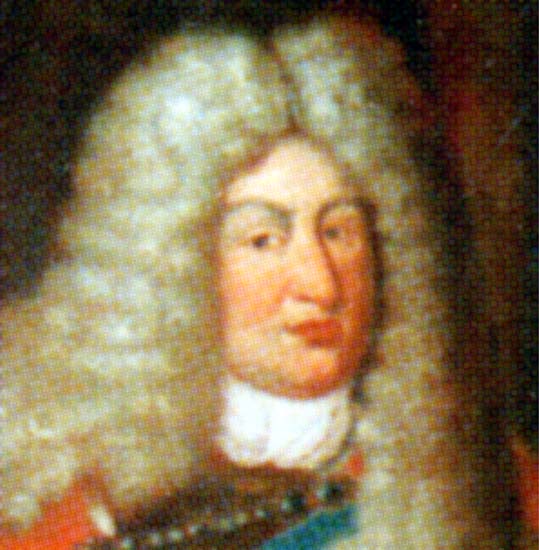
In addition to the ermine trimmed, red velvet cape, I realized that I could just make out what appears to be a white trimmed,
scalloped edged tunic underneath the duke's armor. Needless to say, I began to study the portraits in this catalogue very carefully!
Next a portrait of Johann Adolf I's successor, Duke Christian's older brother, Johann Georg:

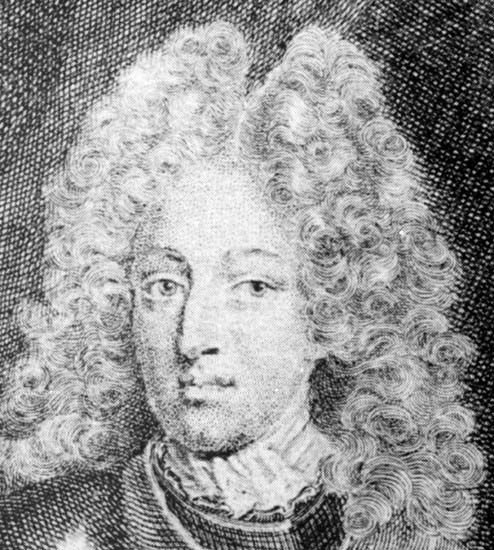
Once again, a white trimmed, scalloped edged tunic under the cuirass. Now, a similar portrait print of Duke Christian von
Sachsen-Querfurt und Weissenfels, which must date from soon after his accession in 1712:


Yet again, a scalloped edged white trim tunic beneath the armor. You will recall that I asked you to keep in mind that engraving of
Christian's successor, Johann Adolf II, the last Duke of Sachsen-Querfurt und Weissenfels, the image that shows the Duke in a
short perruque not much different from the one that Bach is wearing in the Weydenhammer Portrait Fragment:
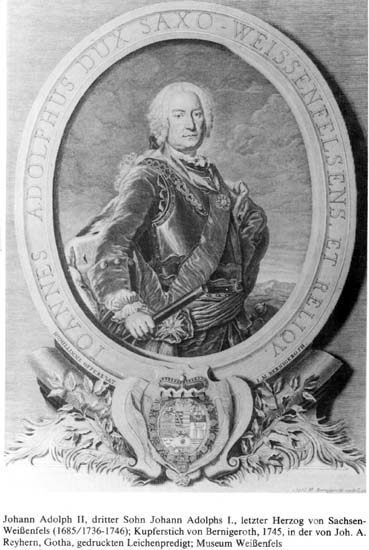
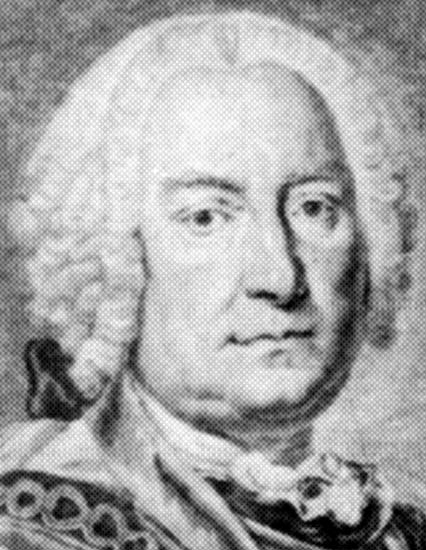
And then I came across a photograph of a portrait in oils of one of Johann Georg's, Christian's, and Johann Adolf II's distant
cousins, the head of a cadet branch of the family that had within the duchy of Sachsen-Querfurt und Weissenfels an autonomous
principality about the size of the five boroughs of the city of New York called Sachsen-Weissenfels-Barby. When I saw this portrait
of Prince Georg Albert von Sachsen-Weissenfels-Barby, who died in 1739 at the age of 44, I knew that I had the final bit of
collateral or circumstantial evidence that I needed to prove beyond a doubt that the portrait of Bach that belonged to Kittel was a
depiction of Bach in his offical regalia as Christian's Capellmeister von Haus aus and that the Weydenhammer Portrait Fragment
depicts Bach in Weissenfels Staatskleide. Unfortunately, the catalogue does not give the dimensions of this oil painting, nor has the
artist who painted the unsigned canvass been identified apparently, but, for the present, no matter. This painting is, if you will, the
smoking gun:
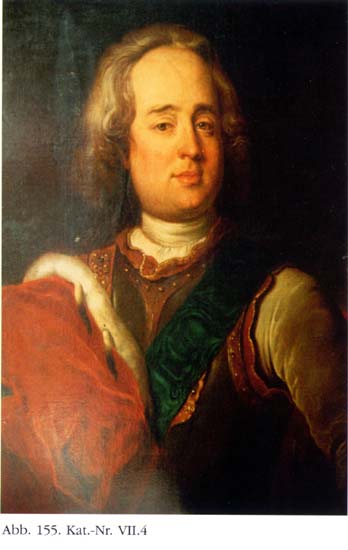
Because Prince Georg Albert is wearing just a cuirass, rather than a full suit of armour and because his cape is flung casually over
his shoulder, we finally can get a good look at the sleeveless tunic that he and his relatives all are shown wearing under their armor.
You will note that the yoke of the neck and the sleeve openings of the tunic, which is red, are scalloped and trimmed in white.
If one "cuts" the head out of the painting and creates a "Weydenhammer Equivalent", the similarity is instantly apparent:

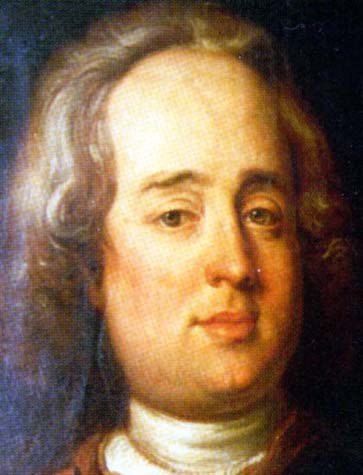
It is incredible, isn't it, that both images now have two scallops in the same place!
Please recall that, in the letter that accompanied the 4x6 snapshots of the Weydenhammer Portrait Fragment that she sent me in
April of last year, Erika Norwood, one of the two sisters who now own the painting jointly, expressed the sentiment, "that somehow
the face could be reunited with the rest of the painting if that were extant". Once again, thanks to that magician Michael V. Cohen
at New York Film Works, I am able to supply her, and you, with a computer generated, digital montage that will provide a good
idea of what the painting must have looked like originally.
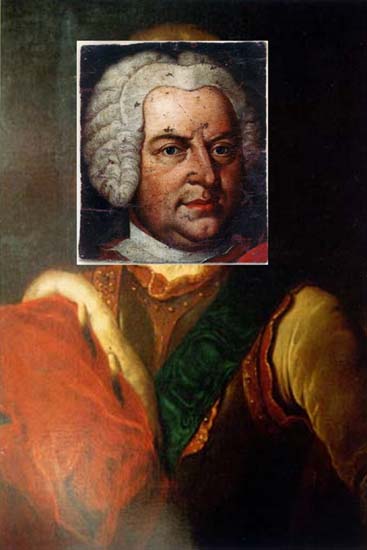
Bach in a cuirass? The concept is a delectable one - Bach girding for battle with the Leipzig Town Council, with Johann August
Ernesti, or with Johann Adolf Scheibe! Somehow or other, though, I suspect that further investigation will turn up other similar
portraits from Weissenfels at this period, portraits that show high level court officials in the scalloped necked tunic but without the
cuirass!
It is now beyond doubt that the Weydenhammer Portrait Fragment is what remains of a portrait in oils of Johann Sebastian Bach in
his official regalia as Capellmeister von Haus aus to Christian, Herzog zu Sachsen-Querfurt-und-Weissenfels, and that it, therefore,
is what remains of the painting that is described by Ernst Ludwig Gerber and Carl Ludwig Hilgenfeldt and that is known to have
belonged to Bach's pupil, Johann Christian Kittel.
Now all that remains is to fill the gaps in the provenance, if that is possible.
Please click on 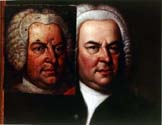 to advance to Page 14.
to advance to Page 14.
Please click on  to return to the Index Page at The Face Of Bach.
to return to the Index Page at The Face Of Bach.
Please click on  to visit the Johann Sebastian Bach Index Page at Teri Noel Towe's Homepages.
to visit the Johann Sebastian Bach Index Page at Teri Noel Towe's Homepages.
Please click on the 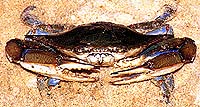 to visit the Teri Noel Towe Welcome Page.
to visit the Teri Noel Towe Welcome Page.
TheFaceOfBach@aol.com
Copyright, Teri Noel Towe, 2000 , 2002
Unless otherwise credited, all images of the Weydenhammer Portrait: Copyright, The Weydenhammer Descendants, 2000
All Rights Reserved
The Face Of Bach is a PPP Free Early Music website.

The Face Of Bach has received the HIP Woolly Mammoth Stamp of Approval from The HIP-ocrisy Home Page.